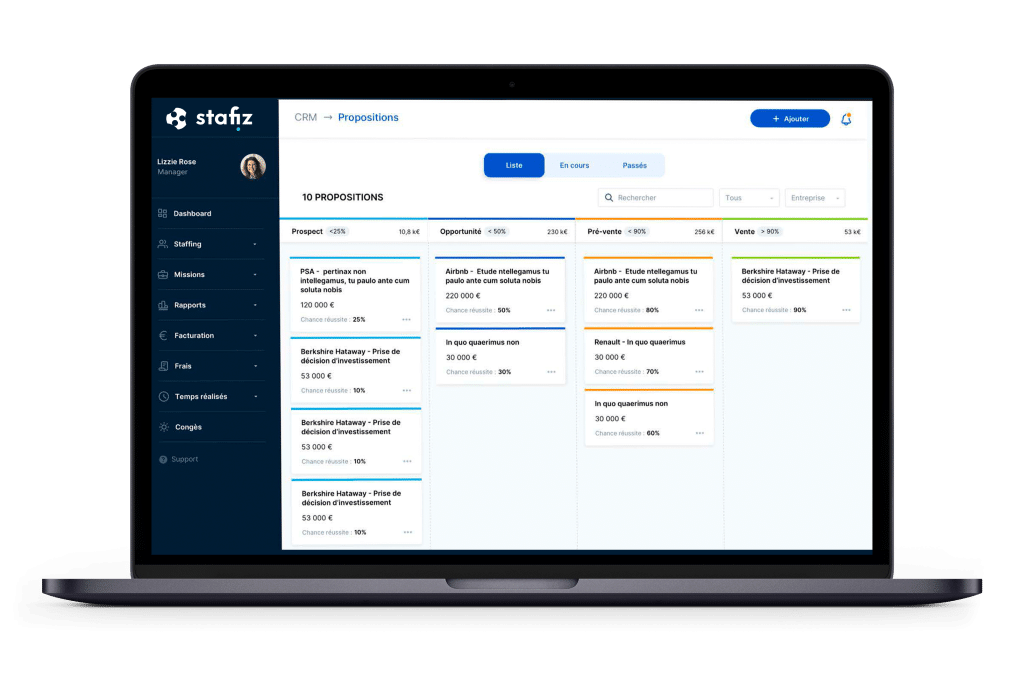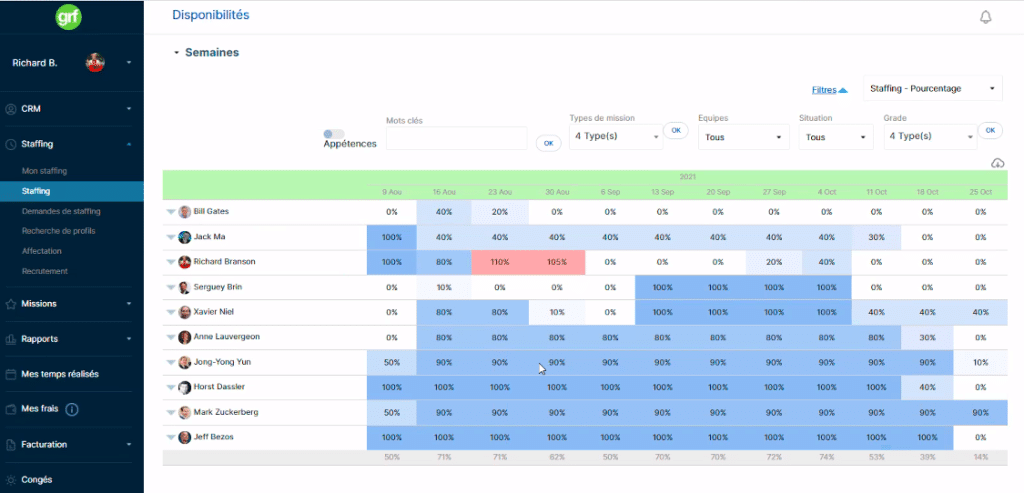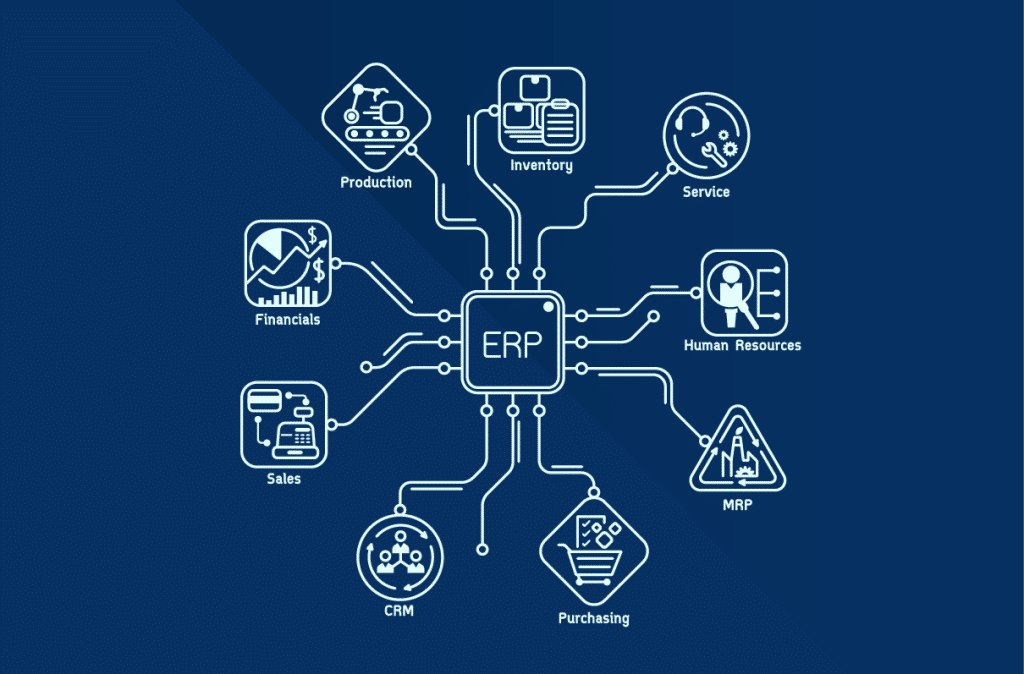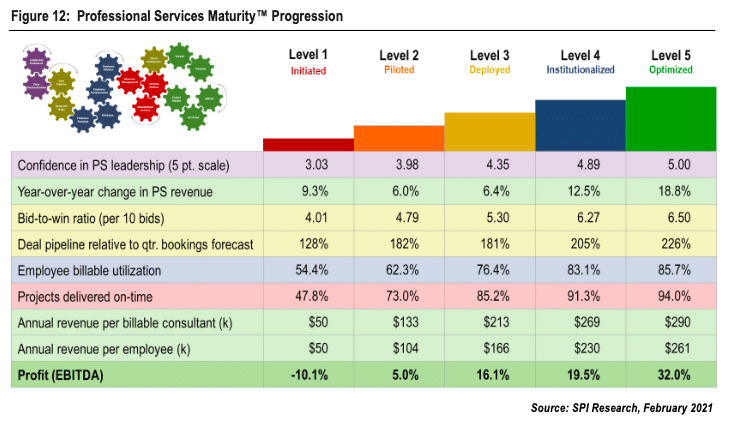How to boost your consulting business?

5 strategies that work to accelerate the performance of a consulting activity
Professional services activities (consulting, agencies, IT Services, studies, training) have in common that they have multiple possible levers to improve the performance of the activity. Depending on the level of maturity of organizations, the differences in performance can be gigantic. A perfectly optimized consulting company, which applies the strategies described in this article, will be able to generate a better turnover. But also, to benefit from a growth in the pipe faster, to display utilization rate and a much higher result than an immature consulting activity. This without process or management.
1. Monitor performance in real time rather than retrospectively
a. No longer be a blind organization: give managers the right data in real time
While the sale of projects is a major issue, it is important not to neglect the management of projects once they are sold. In particular, the monitoring of the profitability of the project. Whether the project is sold as a package (a fixed amount decided with the client) or on a time-and-cost basis (sales amount based on the time spent on the project), it is up to the project manager to ensure that the project's margins remain aligned with the objectives set at the time of budgeting for this project.
At the start of a project, a budget must be created and take into account all the costs of the project to be put in front of the expected turnover:
- The costs of the collaborator(s) according to the time spent on the project
- Possible subcontracting costs
- Expenses, such as travel, meals, which, when they are not rebillable, have an impact on the project's margin
- The cost of any products sold as part of the project (e.g. training, or software licenses, etc.)
During the course of the project, it is important to know at all times:
- What was consumed from the budget
- The Variance Detail: How the time spent in reality on project tasks compares to the budgeted time
- What is the actual cost-effectiveness compared to budgeted
Project managers need to have easy access to this up-to-date data across all the projects they manage.
With this information, they are more responsible and act at their level to improve performance. If each manager leads the improvements at their level, imagine the overall impact.
b. Being able to anticipate in order to better correct
Comparing the performance of a project to what had been budgeted is a good thing. But to be proactive, it is imperative to have predictive data.
It is therefore the projected profitability (or the margin at completion) of the project that must be looked at during the project. This projected profitability takes into account what remains to be done on the project.
Ideally, the remaining work is regularly updated by the project manager, who reviews the progress of the various tasks and confirms the time remaining to be spent.
Thanks to these elements, all the profitability forecast data can be calculated (or given automatically by your management platform). Thanks to this, you identify projects that deviate from their objectives and you carry out the necessary actions before it is too late. For example, if you realize that the projected margin deviates from the budget, you can:
- See with the client to renegotiate the contract. The work may have been poorly described in his specifications
- Take stock of the different tasks to see how to reduce the time spent on each of them
- Reorganize the resource planning on this project, and see if less senior employees (representing a lower cost) can move forward on the project with the same chances of success

Management of the pipe proposal in Stafiz
c. Benefit from more relevant indicators
You can't improve what you can't measure. This adage is also true for the performance of a consulting activity.
Managing a consulting and service activity is not a simple thing. Achieving excellent management allows you to gain a competitive advantage: more relevant reporting that allows better decisions to be made more quickly, offers a strong competitive advantage. Operational excellence leads to better profitability, which in turn allows you to make better investments, which in turn allow you to accelerate your growth. In short, with the right metrics, it is possible to create a virtuous circle of performance improvement.
And what is good reporting?
It is a reporting that provides you with all the key indicators, in real time, on the actual and the forecast, at the granularity that interests you (overall, by division, by sector, by type of employee, etc.)
At the very least, when you manage a consulting activity, you must have the following indicators:
- Turnover
- Margins
- Production in days and value
- ADR Real (Average Daily Rates)
- staff activity rate / TACI / utilization rate
- Employee occupation rate
- Income statements
- Differences between the revenue and the invoiced
Put that data in the hands of managers. Set the objectives to be achieved on each of them. This ensures that these employees are empowered and that they will carry out the actions that will make it possible to reach them.
2. Gain visibility into capacity and projected load
a. Know at a glance the forecast workload level of the teams
The heart of the reactor to improve the performance of a consulting activity is the management of the workload of employees: it is necessary to ensure that the load is better distributed among the different employees. Let them not be too heavily loaded, nor too little loaded.
It is imperative to have the right level of information. This allows us to know if in the coming periods (coming days, weeks, months), our squad has the capacity to hold the load. Or if, on the contrary, the number of students is too large in relation to the needs.
Giving yourself long-term visibility on this aspect of capacity and workload allows you to make better recruitment decisions (should you speed up or slow down recruitment?).
But also to improve employee engagement (ensuring that the workload of employees is adapted).
And to improve the profitability of your business (having the right resources in front of the needs so as not to be over-staffed or understaffed, which can prevent you from winning projects).

Projected load in Stafiz
b. Plan the utilization rate / staff activity rate according to the objectives
One of the key indicators to monitor is the staff activity rate or utilization rate (or billable rate): this is the time spent by employees on billable projects (which will generate turnover) in relation to the time available.
Gaining visibility on this indicator will allow you to have a much better management of your workforce.
Depending on the hierarchical level and roles, the time spent on billable projects is not always the same. It is therefore also necessary to analyse the billable utilization rate or utilization rate by role or by team. You also need to set a goal to be achieved for each type of employee. The objective of billable utilization rate will undoubtedly be different between a junior employee and a director or associate who spends more time selling projects.
Finally, you need to look at the staff activity rate or utilization rate achieved, of course, but also keep an eye on the forecast: to date, what is the TACE achieved in one month, two months, etc.? And therefore, how much do you need to get to reach your objectives?
It is with this type of approach that you will improve your performance and generate more results.
c. Improving the management of resource planning of employees
By doing resource planning A key process of your consulting company, you put the employee at the center of your strategy. You promote employee engagement and satisfaction.
Ensure that teams have full visibility on their projected schedule and empower managers by giving them long-term visibility on the resource planning of their teams are typically actions that pay off by promoting employee engagement and retention.
Managers need to be equipped to better predict the load on their teams. To offer everyone a sufficient burden to feel committed and progress. At the same time, it is important to avoid overloading employees, to avoid demotivation or burnout.
Find out how Stafiz meets the needs of a consulting company.
Read our customers' use cases.
3. Improve the employee experience
a. Provide access to a platform that brings together all their needs
To keep your employees motivated, it's also necessary to provide them with the technology that helps them work simply and more efficiently. The type of technology that allows them to reach their full potential by saving them time on non-value-added tasks and providing them with the right information at the right time.
A good way to save time for your employees is to allow them to centralize their tasks on a single platform. This is the definition of an unpleasant experience for an employee. :
- Log in to a system to confirm your times
- to another app to submit their fees
- and still a third to make requests for leave before going...
- … Search on an Excel for your schedule
This clearly lacks efficiency!
Bringing all these elements together in a single environment available on a computer or smartphone. This is a solution that offers simplicity on a daily basis! And it allows employees to be focused on their mission and their customers. This improvement in the employee experience is a contributor to satisfaction that contributes to retention.
b. Offering the right technology
There are many technologies today that greatly simplify the employee experience. The many gains (productivity, satisfaction, commitment) brought about by these technologies alone justify their acquisition.
Take OCR for expense management, for example. All the employee has to do is take a picture of their receipt and the expense line will be pre-populated with the amount, taxes and date. All that remains for the employee to do is indicate to which project to attach this expense.
Or the probative value. It is no longer necessary to go through the tedious step of keeping receipts in envelopes before photocopying them and attaching them to an expense report. Fortunately, photography is now sufficient. The right expense report management solutions allow you to take advantage of them, by taking care of the storage required by the URSSAF.
Ideally, your employees should be able to access their entire environment from their mobile. Why not take advantage of the metro ride to confirm the time spent on the different projects during the day?
Other technologies, particularly integration between software, also make it possible to simplify and save many hours of administrative management.
c. Using the resource planning to better engage your employees
Improving the employee experience requires resource planning which takes into account more criteria than simple availability. Ideally, skills development should be considered. That is, to ensure that the resource planning of an employee allows them to increase their skills and achieve their progress objectives.
One resource planning Perfectly managed, can even integrate the appetites of employees. Allow them to indicate the type of project they would like to work on or the type of skills they would like to develop. When the resource planning intelligently cross-references more criteria and offer you the most suitable employees according to your criteria, it is the assurance of increasing employee satisfaction and growing talent within your organization to keep them as long as possible.
Stafiz offers you an ERP created specifically for professional services and service companies. More than 48,000 users in 10 countries manage their projects in Stafiz.
4. Gain reliability and control
a. Avoid working on spreadsheets or multiple solutions
Excel is a great tool, but it has one major problem: spreadsheets in general are far from foolproof. Human error or modeling problems are the source of many errors. In addition, the knowledge behind complex spreadsheets is often kept by an employee who, when he leaves the organization, implies the loss of knowledge of the file makes its maintenance too complex. It is often necessary to recreate a new model. Or spend many hours adapting it to understand and exploit it. A waste of time and a risk that no organization should take.
In short, Excel management is suitable for very small structures (less than 10 people) but is not scalable when the activity grows.
So that a company can structure itself and grow in the right conditions. :
- The data that teams use must be reliable
- The risk of errors must be zero.
Another option is sometimes to use several solutions that are not connected to each other. But it also entails a risk. It will undeniably be necessary to extract data from one solution before importing it back into the other. This causes the risk of error, not to mention the loss of time.
Software that performs end-to-end calculations provides more detailed analysis and reliable data. Indeed, the risk of error that humans carry is eliminated. When data is also used to prepare financial closes or payroll, it's even more secure to use a single platform.
b. Define approval levels
Working to improve the reliability of data and better internal control does not necessarily lead to administrative burdens, quite the contrary.
When the various requests (for reimbursement of expenses, leave, etc.) are organized with workflow systems, i.e. approval flows, collaboration and simplicity are only strengthened.
To do this, it is necessary to have clearly defined the approval flows beforehand. These must remain simple to avoid too many validation steps but must intelligently guide the requests according to their nature.
For example, the person best able to approve an expense report is usually the person responsible for the project to which the expense is attached. He or she will be able to confirm whether the expense is justified, whether or not it can be rebilled to the client, whether the employee complies with the company's rules on this project, etc. The project manager is also responsible with this responsibility for monitoring the costs spent on his project. On the other hand, a request for absence will more often be approved by the employee's manager or by HR, who is more likely to have a global view, which is necessary to approve.
This means creating workflows well and ensuring that they are fully automated so that approvals are given quickly, with the right level of control.
c. Enable finance teams to work with reliable data
The management of operations and the associated reporting is crucial. But for the organization to be fully effective, make sure that the data generated by operations offers finance teams reliable data. They will be able to carry out their accounting closes and carry out the management analyses that are required at certain frequencies.
This means that your system must be able to extract data with complete reliability and transmit it to the accounting solution you use to update it. This data transfer can be done either by preformatted files (called "flat files") or by API, i.e. by automated transfer via connectors. To avoid any mistakes, the second option remains the best.

Sales journals, data on expenses to be reimbursed, and subcontracting purchases are then directly transmitted to the accounting system to close and prepare tax returns. Payroll variables (holidays, bonuses, meal vouchers) can also be transferred directly into the payroll software.
This automation helps to avoid human error. All data remains reliable and controlled until it enters the accounting and payroll. Not only is internal control strengthened. But controlling teams gain a lot of productivity and can focus their efforts on value-added analysis for performance. Without it, they can work for hours to complete the financial close.
5. Accelerate your business activity
a. Anticipate new purchasing behaviors
Selling projects is a subtle art. Multiplying exchanges to identify customer needs, provide clear answers and stand out from potential competitors for proposals stand out from the crowd...
The project sale of a consulting activity is a very human process that leaves little room for automation. There are a few major trends to consider when improving your business strategy:
-
Using only referrals and connections to grow the business can be risky.
In just a few years, the search for advice has gone from an approach focused on recommendations obtained through the network to an approach more influenced by internet searches. In 2013, the Hinge Research Institute surveyed buyers of consulting assignments in a study. At that time, 70% of them said they had received a recommendation to choose the consulting firm they wanted to work with. In 2019, they were only 60% and this trend accelerated in 2021.
-
Buyers place more importance on technical skills when selecting a consulting firm
Expertise has become a key element in a highly digitalized world that requires technical aspects, code and developments to improve business performance. The differentiation of service providers is stronger than before, when generalist profiles were preferred.
-
Buyers consider consulting activities more useful and important than in the past
While in 2013, only 19% of clients considered their consulting providers to be decisive in solving their problems, this figure jumped to 29%.
b. Integrate digital and growth marketing skills within your organization
While the commercial development of a consulting activity must favor the human approach, modernizing marketing methods is nevertheless a necessity for any consulting activity that wishes to accelerate its development. We must prioritize visibility and multiply opportunities to interact. And this is where growth marketing methods can be extremely useful for a consulting activity:
- Putting content online that brings maximum value on topics of expertise helps to establish credibility and improve SEO performance to be more visible when a search is made on search engines. The first step is to regularly post articles on the company's blog. If the content is important (it must bring maximum value to readers), its distribution is just as important: a poorly referenced article is unlikely to generate new leads. Before writing an article, you need to define the distribution strategy.
- Frequent communication on social networks is also a simple way to gain visibility and highlight expertise. And there, nothing works better than having the employees themselves get involved and highlight their expertise by participating in online discussions, commenting on posts or publishing articles that may be of interest to your targets.
- Developing your growth also means expanding your audience by sending personalized messages to well-identified contacts who fit your target. To recover these contacts, there are now many perfectly legal methods to "scrape" LinkedIn and obtain the email addresses of these contacts (Phantombuster for example). In a process of distributing professional content and respecting certain rules, there is no GDPR problem when you broadcast content that may interest them. As long as they have a link to stop the process if they wish. This content can be found through newsletters, emails or blog articles. Growth techniques allow you to automate the search for contacts, emails, and even phones, which increases the power of your marketing tenfold.
c. Follow your pipe and anticipate your forecast
To improve the performance of a consulting activity, you need to have precise visibility on what is going to happen:
- Know the projected turnover
- Projected employee load and capacity
- Projected profitability
- All these elements are crucial to anticipate problems well in advance and to be able to correct them.
Without this visibility on the forecast, there is no possible management. The management of the activity is endured.
It is therefore necessary that projects are visible in their pre-sales phase, with the possibility of weighting the associated turnover according to the chances of success. This data will make it possible to complete the forecast based on the projects already sold and give a complete and more realistic view of the forecast.
Ideally, these projects that are still at the proposal stage allow you to also plan the associated budget in terms of resources and therefore the associated profitability.
Even better, if you can script the resource planning of these projects from pre-sales. This gives you a head start by having a much more accurate visibility of the projected workload and possible recruitment needs.

The challenge to improve the performance of a consulting firm is clear: to put in place the technologies and tools to simplify tasks, to gain visibility on performance and to improve collaboration. This transformation is vital to take a business to a more mature state, which undeniably generates a much higher performance.
The most successful consulting activities are those that have made this choice. A 2021 study from SPI Research, a research and consulting firm that helps service providers like consulting firms make headway, showed glaring evidence of gaps between consulting firms based on their equipment. Companies that had a complete management platform had 3 times higher revenue growth, utilization rate 1.8 times higher and EBITDA 5 times higher, compared to non-equipped companies.

Stafiz helps service companies and consulting firms to gain visibility, manage their activity, manage their resource planning and their project progress thanks to real-time data. Stafiz is a SaaS for managing the resource planning, project management and Business Intelligence. This way, budgets and margins are always respected and you make better decisions for your business.
If you too want to improve the performance of your consulting business, don't wait.


